
Venkateswara, also known as Venkatachalapati, Balaji and Srinivasa, is a major deity in Hinduism. Described as an avatar of Vishnu, he is the presiding deity of Venkateshwara Temple, Tirupati. His consorts, Padmavathi and Bhudevi are avatars of Lakshmi.

The Ranganathaswamy Temple is a Hindu temple dedicated to Ranganatha and is located in Srirangam, Tiruchirapalli, Tamil Nadu, India. Constructed in the Dravidian architectural style, the temple is glorified by the Tamil poet-saints called the Alvars in their canon, the Naalayira Divya Prabhandam, and has the unique distinction of being the foremost among the 108 Divya Desams dedicated to the god Vishnu. The Srirangam temple is the largest temple compound in India and is one of the largest religious complexes in the world. Some of these structures have been renovated, expanded and rebuilt over the centuries as a living temple. The latest addition is the outer tower that is approximately 73 metres (240 ft) tall, it was completed in 1987. Srirangam temple is often listed as the largest functioning Hindu temple in the world, the still larger Angkor Wat being the largest existing temple. The temple is an active Hindu house of worship and follows the Tenkalai tradition of Sri Vaishnavism. The annual 21-day festival conducted during the Tamil month of Margali (December–January) attracts 1 million visitors. The temple complex has been nominated as a UNESCO World Heritage Site, and is in UNESCO's tentative list. In 2017 the temple won the UNESCO Asia Pacific Award of Merit 2017 for cultural heritage conservation, making it the first temple in Tamil Nadu to receive the award from the UNESCO.

The Sri Venkateswara Swami Temple is a Hindu temple situated in the hills of Tirumala at Tirupati in Tirupati district of Andhra Pradesh, India. The temple is dedicated to Venkateswara, a form of Vishnu, who is believed to have appeared on the earth to save mankind from trials and troubles of Kali Yuga. Hence the place is also known by the name Kaliyuga Vaikuntha and the deity here is referred to as Kaliyuga Prathyaksha Daivam. The temple is also known by other names like Tirumala Temple, Tirupati Temple and Tirupati Balaji Temple. Venkateswara is known by many other names: Balaji, Govinda, and Srinivasa. The temple is run by Tirumala Tirupati Devasthanams (TTD), which is under control of Andhra Pradesh Government. The head of TTD is appointed by Andhra Pradesh Government.
Sri Venkateshwara Swami Temple is a landmark vaishnavite temple situated in the hill town of Tirumala at Tirupati in Chittoor district of Andhra Pradesh, India. The Temple is dedicated to Lord Venkateswara, an incarnation of Vishnu, who is believed to be appeared here to save mankind from the trials and troubles of Kali Yuga.

Thirukkadigai or Sholingapuram in Sholinghur, a village in Ranipet district of the South Indian state of Tamil Nadu, is dedicated to the Hindu god Vishnu. Constructed in the Dravidian style of architecture, the temple is glorified in the Naalayira Divya Prabandham, the early medieval Tamil canon of the Alvar saints from the 6th–9th centuries CE. It is one of the 108 Divya Desams dedicated to Vishnu, who is worshipped as Lakshmi Narasimhar, and his consort Lakshmi as Thirumamagal. There are three separate shrines in the form of Narasimha, Bhaktavatsala Perumal and Hanuman (Anjaneya). They are situated on the larger hill, at the base of the larger hill and on the smaller hill, respectively.

Veeraraghava Swamy Temple is a temple dedicated to the Hindu god Vishnu, located in Tiruvallur, Chennai Metropolitan City, an area and headquarters in Tiruvallur district in the South Indian state of Tamil Nadu. Constructed in Dravidian style of architecture, the temple is glorified in the Divya Prabandham, the early medieval Tamil canon of the Alvar saints from the 6th–9th centuries CE. It is counted as one among the 108 Divya Desams dedicated to Vishnu. Vishnu is worshipped as Veeraraghava Perumal, and his consort Lakshmi as Kanakavalli Thayar.
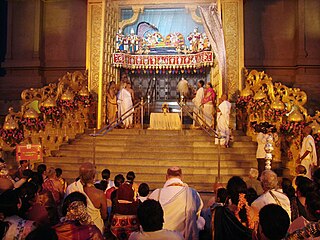
Vaikuntha Ekadashi is a Hindu occasion and festival. It is primarily observed by Vaishnavas, who regard it to be a special ekadashi. It coincides with Mokshada Ekadashi or Putrada Ekadashi. It is observed on the 11th lunar day of the waxing lunar fortnight of the solar month of Dhanu. This falls between 16 December and 13 January in the Gregorian calendar.
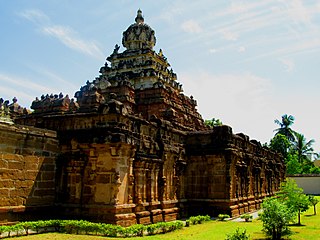
Thiru Parameswara Vinnagaram or Vaikunta Perumal Temple is a Hindu temple dedicated to the God Vishnu, located in Kanchipuram in the Southern Indian state of Tamil Nadu. Constructed in the Dravidian style of architecture, the temple is glorified in the Nalayira Divya Prabandham, the early medieval Tamil canon of the Alvar saints from the 6th through the 9th centuries CE. It is one among the 108 Divya Desams dedicated to the God Vishnu, who is worshipped as Vaikuntanathan and his consort, the Goddess Lakshmi as Sri Vaikundavalli. The temple is considered the second oldest extant temple in Kanchipuram after the Kailasanathar temple.
Sri Venkatachalapathy Temple is a temple situated in Trivandrum, Kerala, about a minute walk from the southern gate of Sri Padmanabhaswamy Temple. It is also known as Srinivasar kovil, Perumal Kovil, Iyyengar Kovil or Desikar Sannidhi. The temple was built in 1898. The poojas in Kerala temples are based on the Namboodiri sampradayam, except a few like this.
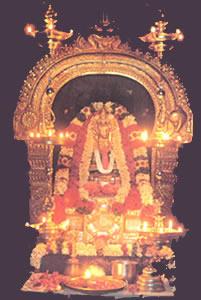
Sri Venkatesa Perumal Temple (Melathiruppathi) – Mondipalayam is counted among the noted Vishnu temples of Kongunadu. The image of the lord is flat on the four sides and conical in the center. The form was first discovered by one Kondamanaicker around 300 years ago. The devotee once sighted his cow shedding her milk on a sandhill. Induced by curiosity, he dug it, when manifested the image with Conch (Sanguchakkram) and Disc (Chakkram) as well as Saligram and Chikandi (weapon). Inspired by the divine revolution, he ordered a temple to be built up for Sri Venketachalapathi enshrining the form. Devotees who have taken vows to make offering to the lord of the seven hills can fulfill them in Mondipalayam, in the event of their inability to go to Tirupati.

The Thiru Aadanoor or the Andalakkum Aiyan Perumal Temple is a Hindu temple dedicated to Vishnu located in Aadanoor, Thanjavur district in Tamil Nadu, India. Constructed in Dravidian style of architecture, the temple is glorified in the Nalayira Divya Prabandham, the early medieval Tamil canon of the Alvar saints from the 6th–9th centuries CE. It is counted as one among the 108 Divya Desams dedicated to Vishnu. Vishnu is worshipped as Andalakkum Aiyan and his consort is worshipped as Ranganayaki, a form of Lakshmi.

The Bhu Varaha Swamy temple is a Hindu temple, located at Srimushnam, in the South Indian state of Tamil Nadu. Constructed in the South Indian style of architecture, the temple is dedicated to Varaha, the boar-avatar of the god Vishnu and his consort Lakshmi as Ambujavalli Thayar. It is Classified one among the 108 Abhimana Kshethram of Vaishnavate tradition. One of the greatest Hindu scholars of Vaishnava Tattvavada (Dvaita) philosophy, Madhvacharya, have come and resided in this temple many times.
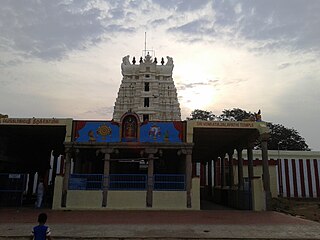
Krishnapuram Venkatachalapathy temple in Krishnapuram, a village in Tirunelveli district in the South Indian state of Tamil Nadu, is dedicated to the Hindu god Vishnu. It is located 10 km from Tirunelveli. Constructed in the Dravidian style of architecture, the temple is a storehouse of Nayak architecture.

Adi Kesava Temple is dedicated to Hindu god Vishnu located in Sriperumbudur, Kanchipuram district, in the South Indian state of Tamil Nadu. Constructed in the Dravidian style of architecture, Vishnu, who is worshipped as Adi Kesava, and his consort Lakshmi as Ethiraja Nadhavalli. The temple is believed to be the birthplace of Ramanuja, the exponent of Vishishtadvaita philosophy. The gold plated shrine in front of the hall of Ramanuja was built by the Maharaja of Mysore. It is considered one among the 108 Abhimana Kshethram of Vaishnavate tradition.

Abaya Hastha Swayambu Sri Lakshmi Narasimha Swamy Temple is a holy Hindu religious site in the village of Agaram Agraharam in Hosur taluk of Krishnagiri district in the Indian state of Tamil Nadu. It is located 15 km from Hosur on Rayakotta Road and 65 km from Bangalore.
Sri Narapura Venkateswara Temple is an ancient Hindu temple situated in Jammalamadugu, YSR Kadapa District, Andhra Pradesh India. The temple is dedicated to the Hindu god Venkateswara, a form of Vishnu, who is referred to as Narapura Venkateswara. According to the temple history, the temple derives its name from Narapuraiah, a devotee of Venkateswara, who constructed this temple based on what he considered the deity's wishes. Within the main premises of the temple, there is Anjaneya temple, Kalyana Mantapam, and Goshala. The temple has been under the control of TTD since 2008. The temple is generally crowded on Saturdays being it a significant day for Venkateswara.
Sri Santhana Venugopala Swamy is an ancient Hindu temple in Thettu Village, Kurabalakota Mandal, Chittoor district, Andhra Pradesh. The Lord Venugopala Swamy Temple and Goddess Paleti Gangamma Temple are the places of worship in the village of Thettu. This deity is also known as Bala Gopala, Hucchu Gopala, or Sri Santana Venugopala.
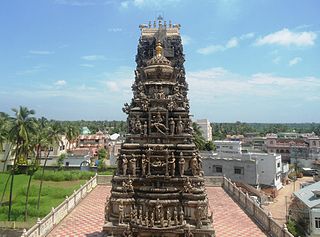
Kodandarama Temple is a Hindu temple located in Gollala Mamidada in Kakinada district of Andhra Pradesh, India. The temple is dedicated to Rama, the seventh incarnation of Vishnu. It was built on the banks of Tulyabhaga (Antharvahini), a tributary of Godavari.
The Yogananda Lakshmi Narasimha Swamy Temple, also known as Mattapalli Narasimha Temple, is a Hindu temple dedicated to Narasimha, the half-man half-lion avatar of Vishnu, and his consort Lakshmi. It is located in Mattampally, a village in the Mattampally mandal of Suryapet district in the Indian state of Telangana. One of the Pancha Narasimha Kshetras, the temple is located on the banks of the Krishna River, and was built in the 11th century by Anumala Machi Reddy, the king of Thangedu region after the deity appeared in his dream and instructed him to do so. The main shrine houses a swayambhu (self-manifested) idol of Narasimha as Yogananda Lakshmi Narasimha, and was worshipped by sage Bharadvaja and other seers for hundreds of years before the temple was constructed. Lakshmi is worshipped here as Rajalakshmi Thayar and Chenchu Lakshmi Thayar.

Sundararaja Perumal Temple, Salem is located on the banks of the Thirumanimutharu river at Salem, Tamil nadu, India. The temple is Classified one among the 108 Abhimana Kshethram of Vaishnavate tradition. The other significance of the temple is that it is one of the Pancha Kshethram where Maha Lakshmi was born as Bhargavi- the daughter of Maharishi Bhrigu. The other four temples of the Pancha Kshethram are Sarangapani temple, Kumbakonam, Oppiliappan temple, Nachiyar Koil and Venkateswara Temple, Tirumala. The temple is believed to be of significant antiquity with contributions at different times from Medieval Cholas, Vijayanagara Empire, Chera, Pandyas and Madurai Nayaks. The temple follows Vaikhanasa agama and the temple priests perform the pooja rituals during festivals and on a daily basis. The priests belong to the Vadakalai sect of Vaishnavism, a Brahmin sub-caste. The temple rituals are performed six times a day: Ushathkalam at 7 a.m., Kalasanthi at 8:00 a.m., Uchikalam at 12:00 p.m., Sayarakshai at 6:00 p.m., Irandamkalam at 7:00 p.m. and Ardha Jamam at 10:00 p.m. Each ritual has three steps: alangaram (decoration), neivethanam and deepa aradanai for both Ranganatha Perumal and Ranganayagi. During the last step of worship, nagaswaram and tavil are played, and religious instructions in the Vedas are recited by priests.
















